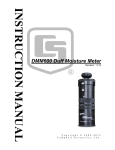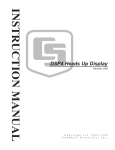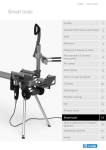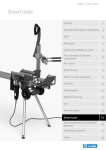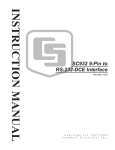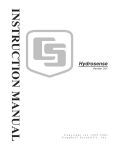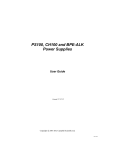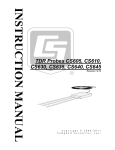Download Campbell DMM600 Instruction manual
Transcript
INSTRUCTION MANUAL DMM600 Duff Moisture Meter 5/02 C o p y r i g h t ( c ) 2 0 0 2 C a m p b e l l S c i e n t i f i c , I n c . Warranty and Assistance The DMM600 DUFF MOISTURE METER is warranted by CAMPBELL SCIENTIFIC, INC. to be free from defects in materials and workmanship under normal use and service for twelve (12) months from date of shipment unless specified otherwise. Batteries have no warranty. CAMPBELL SCIENTIFIC, INC.'s obligation under this warranty is limited to repairing or replacing (at CAMPBELL SCIENTIFIC, INC.'s option) defective products. The customer shall assume all costs of removing, reinstalling, and shipping defective products to CAMPBELL SCIENTIFIC, INC. CAMPBELL SCIENTIFIC, INC. will return such products by surface carrier prepaid. This warranty shall not apply to any CAMPBELL SCIENTIFIC, INC. products which have been subjected to modification, misuse, neglect, accidents of nature, or shipping damage. This warranty is in lieu of all other warranties, expressed or implied, including warranties of merchantability or fitness for a particular purpose. CAMPBELL SCIENTIFIC, INC. is not liable for special, indirect, incidental, or consequential damages. Products may not be returned without prior authorization. The following contact information is for US and International customers residing in countries served by Campbell Scientific, Inc. directly. Affiliate companies handle repairs for customers within their territories. Please visit www.campbellsci.com to determine which Campbell Scientific company serves your country. To obtain a Returned Materials Authorization (RMA), contact CAMPBELL SCIENTIFIC, INC., phone (435) 753-2342. After an applications engineer determines the nature of the problem, an RMA number will be issued. Please write this number clearly on the outside of the shipping container. CAMPBELL SCIENTIFIC's shipping address is: CAMPBELL SCIENTIFIC, INC. RMA#_____ 815 West 1800 North Logan, Utah 84321-1784 CAMPBELL SCIENTIFIC, INC. does not accept collect calls. DMM600 Table of Contents PDF viewers note: These page numbers refer to the printed version of this document. Use the Adobe Acrobat® bookmarks tab for links to specific sections. 1. Introduction.................................................................1 1.1 DMM600 Packing List .............................................................................2 2. Specifications .............................................................2 3. Description of DMM600 ..............................................2 3.1 Sample Chamber .......................................................................................3 3.2 Electronics ................................................................................................3 3.3 Display End...............................................................................................4 3.3.1 Power Switch ..................................................................................4 3.3.2 Audible Indicator ............................................................................4 3.3.3 Display ............................................................................................4 3.3.4 Serial Port .......................................................................................4 4. Discussion of Water Content Measurement with DMM600..................................................................5 4.1 Discussion of Gravimetric and Volumetric Water Content.......................5 4.1.1 Determining Duff Sample Bulk Density .........................................6 4.2 Duff Size and Water Content Heterogeneity.............................................6 4.3 The Water Content Measurement Method ................................................7 4.4 DMM500 Standard Calibration ................................................................7 5. PCDMM Software ........................................................8 5.1 Introduction...............................................................................................8 5.2 Calibration Equation .................................................................................9 5.3 Description of PCDMM Functions ...........................................................9 5.3.1 Menus..............................................................................................9 5.3.2 Indicators.......................................................................................10 5.3.3 Command Buttons.........................................................................10 6. Calibration .................................................................10 6.1 General Discussion .................................................................................10 6.2 Equipment Required for a Calibration ....................................................10 6.3 Calibration Procedure .............................................................................10 6.3.1 General Description of Calibration Procedure ..............................10 6.3.2 Detailed Calibration Procedure .....................................................11 i DMM600 Table of Contents 7. Maintenance ..............................................................12 7.1 Changing the 9-Volt Battery .................................................................. 12 8. Drying Samples and Calculating Volumetric Water Content ......................................................12 8.1 Conventional Oven Method ................................................................... 12 8.2 Microwave Oven Method....................................................................... 13 Figures 1. DMM600.................................................................................................... 3 2. Downloading coefficients to convert to gravimetric water content for above example......................................................................................... 6 3. DMM600 Standard Calibration.................................................................. 8 4. PCDMM User Interface Display................................................................ 9 ii DMM600 Duff Moisture Meter 1. Introduction The DMM600 Duff Moisture Meter is the product of collaboration between Campbell Scientific, Inc. and USDA-Forest Service, Rocky Mountain Research Station and Missoula Technology and Development Center. The DMM600 measures volumetric water content of organic forest floor material. It is a portable, battery-powered device that uses measurement methods that are sensitive to the dielectric permittivity of the material being measured. The dielectric permittivity is strongly dependent on the water content of the forest floor material. The forest floor can contain several kinks of organic material including a litter layer, the recognizable plant debris that has not decomposed; the fermentation layer, partially decomposed litter often bound with fungus; and the humus layer, extensively decomposed unrecognizable organic material. Duff is an inclusive term that refers to the fermentation and humus layers. Duff thickness and duff water content strongly influence duff consumption and soil heating during fires. The parts of the DMM600 include a cylinder that houses the electronics, a sample chamber, and an LCD readout. To measure duff water content, the sample is placed in the sample chamber, the lid is attached, and the sample is compressed to a density determined by precision springs. When proper density is reached, an audible indicator sounds and the result is displayed on the readout. Readings are displayed in real time. There is no memory for measurement storage. A standard calibration converts the output of the measurement circuit to volumetric water content. Alternatively, a user-defined calibration can be downloaded using PC software PCDMM which is supplied with the DMM600. When user-defined calibrations are used, measurements derived from the standard calibration and the user-defined calibration are alternately displayed on the LCD. PCDMM is software supplied with the DMM600 and provides an interface using serial communications. PCDMM allows downloading and uploading of calibration coefficients, checking battery voltage and resetting the DMM600. DMM600 comes with a 3 inch (7.5 cm) diameter sieve, and a case for easy carrying and storage for small items including a spare battery, screwdriver and pencil. 1 DMM600 Duff Moisture Meter 1.1 DMM600 Packing List The following are included with the DMM600: 1. Carrying case. 2. CD containing (a) video instruction, (b) PCDMM software, (c) DMM600 operating manual, and (d) a sample Excel spreadsheet for calibrations. 3. 3 inch (7.5 cm) diameter # 4 sieve. 4. 6 foot, 9-conductor cable for serial communications between DMM600 and PCTDR. 5. Screwdriver. 6. Spare 9 volt battery. 2. Specifications Physical Dimensions: 3.5" diameter, 10" length Weight: 3.7 lb. Power 9 volt alkaline battery. Battery should be replaced when voltage is ≤ 7 volts. Battery voltage is checked using PCDMM software supplied with DMM600. Current demand between measurements: approximately 3 milliamps The DMM600 automatically turns off after 5 minutes of inactivity. Sleep mode current: 140 microamps Measurement current: 85 milliamps for approximately 1 millisecond Measurements from one battery: more than 2000 measurements Performance Accuracy ±5% full scale range Resolution 1% volumetric water content 3. Description of DMM600 The DMM600 is cylindrically shaped with a sample chamber on one end and a display on the other. Electronics for the water content measurement and serial communications with a PC are housed in the central part of the cylinder. 2 DMM600 Duff Moisture Meter FIGURE 1. DMM600 3.1 Sample Chamber The sample chamber holds the sample during measurement. The sample chamber is accessed by loosening the chamber access thumbscrew, rotating the sample chamber cap slightly counter-clockwise and lifting the cap away from the sample chamber. A piston located inside the cap is attached to the compression knob by a threaded shaft. With the sample in the sample chamber, the compression knob is turned to compress the sample for measurement. The knob is also used to relax the sample for removal. The bottom of the sample chamber is a printed circuit board containing a waveguide attached to piston. A high frequency signal is coupled to the waveguide from the electronics in the main cylinder. The presence of water in the sample determines the response of the circuit which is converted to water content using a calibration equation. The waveguide is attached to a piston which moves against precision springs to obtain correct compression of sample. The sample chamber can be removed for cleaning by removing the chamber removal screw and rotating the sample chamber slightly counter-clockwise. 3.2 Electronics The electronics are housed inside the main cylinder of the DMM600. The electronics for the measurement are located below the sample chamber, and the electronics for display and serial communications are located behind the display. 3 DMM600 Duff Moisture Meter 3.3 Display End 3.3.1 Power Switch A toggle switch turns the DMM600 on and off. A single beep sounds when the DMM600 is turned on. To conserve battery power, the DMM600 will automatically turn off after about 5 minutes of inactivity. If the DMM600 is in the power-saving mode, toggling the power switch or compressing the sample will restore measurement mode. 3.3.2 Audible Indicator The audible indicator uses a port to the side of the power switch. 3.3.3 Display A two-line, 16 character LCD provides measurement results. When the DMM600 is turned on the display is: DMM600 Compress sample When the sample is compressed and measurement made, the display is: Std Cal: xx% Freq: xx.xMHz With Std Cal the standard calibration and Freq the frequency from the measurement circuit. If a user-defined calibration is loaded in the DMM600, the display is: name Cal: xx% Freq: xx.xMHz with name the name given to the user defined calibration as specified in PCDMM software. The display will alternate every 3 seconds between the standard and user-defined calibration. 3.3.4 Serial Port The DMM600 serial port is used for direct connection to the serial port of a computer using a 9-conductor cable. The port should be kept covered with the plastic cover to protect from damage when not being used. PCDMM is the interface software. 4 DMM600 Duff Moisture Meter 4. Discussion of Water Content Measurement with DMM600 4.1 Discussion of Gravimetric and Volumetric Water Content The DMM600 is sensitive to water content on a volume basis, i.e. volumetric water content. Volumetric water content is the volume of water in a given volume of material. Gravimetric water content is a weight-basis parameter and is the ratio of the mass of water to the mass of the material with no water. Volumetric and gravimetric water content are related by the bulk density of the material. Multiplying gravimetric water content by material bulk density yields volumetric water content. The choice of water content description, whether gravimetric or volumetric, is largely traditional in different professions. It is important to understand the difference and how to convert between them. The DMM600 presents water content measurement results in volumetric terms because that is what the DMM600 measures. Conversion to gravimetric requires knowledge of the material bulk density. Bulk density of duff tends to be similar for many forest types. If the bulk density of a particular material is known or measured, the displayed volumetric water content value is easily converted to gravimetric by adjusting the calibration coefficients. As an example, consider that the bulk density of a lodgepole pine was 3 determined to be 0.25 g/cm . The calibration equation to convert circuit output frequency to volumetric water content is VolumetricWater Content = 5.288 + 5.905 * freq − 0142 . * freq 2 To convert to gravimetric water content, each calibration equation coefficient is divided by the bulk density. Applying for this example gives GravimetricWater Content = 21152 . + 23.620 * freq − 0.568 * freq 2 NOTE This is not a general calibration equation but an example. PCDMM can be used to load the modified calibration equation. When downloaded, the DMM600 will alternately display volumetric water content using standard calibration and gravimetric water content using the modified equation. 5 DMM600 Duff Moisture Meter FIGURE 2. Downloading coefficients to convert to gravimetric water content for above example. 4.1.1 Determining Duff Sample Bulk Density The bulk density of the sample at time of measurement is determined as follows. 1. After the measurement is made, count the number of compression knob rotations required to move compression piston from measurement position to completely out. 2. Use following equation to calculate volume of sample at time of measurement. Volume = 157.97 − 7.25 * rotations 3. Dry then weigh the sample used for the measurement. 4. The bulk density in g/cm is the dry weight divided by the volume. 3 4.2 Duff Size and Water Content Heterogeneity There is considerable variability in both the physical characteristic and water content distribution in duff. Because this variability can be significant over a small area or even within a handful-sized sample, several measurements of the material are needed to obtain reliable estimates of the water content for the area of interest. Duff commonly varies in fragment size, and it may be necessary to grind or chop the material to improve measurement accuracy and repeatability. A #4 6 DMM600 Duff Moisture Meter sieve is included with the DMM600 for this purpose. Forcing the sample material through the sieve will improve measurement accuracy and repeatability. The heterogeneity of material size can be characterized by making repeated measurements of the same material. Place the duff in the sample chamber and make a measurement. Remove the duff from the chamber, restore its natural structure by working it by hand then put the duff back in the sample chamber and make another measurement. Repeat this several times. If the measurements vary by more than about 5% water content, this indicates that the material should be sieved before measuring to reduce the effect of the fragment size variation. 4.3 The Water Content Measurement Method 1. Unscrew compression knob completely then loosen (don’t remove) the captive screw and remove sample chamber cap by turning slightly counter-clockwise and lifting. 2. Place duff in the sieve then place the sieve atop the sample chamber. 3. Finger-work the duff in the sieve until it moves through the sieve and into the sample chamber. The sieve may need to be filled more than once to fill the chamber. The sample should fill the sample chamber to about the beginning of the bevel on the top edge. Don’t overfill the chamber or the compression piston may bind. 4. Remove the sieve, ensure that the compression knob is fully out and replace the sample chamber cap by aligning the slots of the cap with the pins of the sample chamber. Turn cap slightly clockwise and tighten the captive screw. 5. Turn on the DMM600 then turn the compression knob clockwise until the double-beep audible signal indicates the measurement has been made, the volumetric water content value is read from the display. 6. Read water content from display. If user calibrations are loaded, the display will toggle between factory and user values. Water content is only displayed while sample is compressed. 7. Turn knob counter-clockwise to stop. A single beep indicates the sample is no longer compressed and the measured water content value is no longer displayed. Loosen the captive screw, remove the sample chamber cap and remove the sample from the sample chamber. If residual water is apparent on the sample chamber surfaces, wipe dry. 4.4 DMM600 Standard Calibration Figure 3 shows the response of the DMM600 as described using the standard calibration that was derived by Campbell Scientific using duff from lodgepole pine, spruce, Douglas fir, larch and oak vegetation types. The error bars indicate that the measurement accuracy decreases as water content increases. 7 DMM600 Duff Moisture Meter The accuracy is approximately ± 4.0% at 60% volumetric water content and approximately ± 1.5% at 30% volumetric water content. Measurements on materials that are highly heterogeneous in fragment size will provide less accurate results. DMM600 calibration 70 volumetric water content (%) 60 50 40 30 20 10 0 28 30 32 34 36 frequency (MHz) 38 40 42 FIGURE 3. DMM600 Standard Calibration 5. PCDMM Software 5.1 Introduction PCDMM is PC software used to download user defined calibrations, retrieve calibration coefficients from DMM600, reset DMM600 and monitor battery voltage. 8 DMM600 Duff Moisture Meter FIGURE 4. PCDMM User Interface Display 5.2 Calibration Equation The frequency output of the DMM600 is converted to water content using a calibration equation. The response of the DMM600 to changing water content is best described with a quadratic calibration equation. A factory calibration is part of the DMM600 operating system and will always be displayed. The factory calibration to convert frequency (MHz) to volumetric water content is: VolumetricWater Content = 5.288 + 5.905 * freq − 0142 . * freq 2 User derived calibrations are easily loaded to the DMM600 using PCDMM. The coefficients from the calibrations are entered into the appropriate box then Send Calibration button is used to transfer the values to the DMM600. 5.3 Description of PCDMM Functions This information is also available from the HELP menu. 5.3.1 Menus Options/Comx selects computer serial communications port x. Options/Disconnect terminates serial communications. Options/Exit terminates program PCDMM. 9 DMM600 Duff Moisture Meter 5.3.2 Indicators Three circles provide serial communications information. The left circle indicates which serial communications port is selected. The circle is green when the connection is successfully made. The TX circle is green during transmission from the computer to the DMM600. The RX circle is red during transmission from the DMM600 to the computer. 5.3.3 Command Buttons Send Calibration Coefficients sends calibration name (maximum of 4 characters) and the user-specified calibration coefficients to the DMM600. Receive Calibration Coefficients receives and displays calibration name and calibration coefficients from DMM600. Read Battery Voltage reads voltage of 9 volt battery in DMM600 and displays value. Reset DMM600 calibration removes any user-defined calibration and sets calibration to factory default. 6. Calibration 6.1 General Discussion The factory supplied calibration was derived using duff from lodgepole pine, spruce, Douglas fir and larch forests. The response of the DMM600 is similar for these types of duff. If the DMM600 is used with significantly different materials, a material-specific calibration can be derived. 6.2 Equipment Required for a Calibration • plastic bags to store samples • a scale to measure sample weight • containers to hold samples for weighing and while drying in oven • a drying oven or microwave to dry samples 6.3 Calibration Procedure 6.3.1 General Description of Calibration Procedure The calibration requires duff samples with a range of water contents. The collected sample will be measured with the DMM600, removed from the DMM600 and weighed, then dried and weighed. Water will be added to the 10 DMM600 Duff Moisture Meter samples to obtain samples with a range of water contents, and the measurement process repeated on the wetted samples. 6.3.2 Detailed Calibration Procedure Spreadsheet file DMM600 calibration spreadsheet.xls is provided with the DMM600 to assist with calibration calculations. 1. Collect a sample of the material to be used in the calibration that is four to five times the volume of the sample chamber. Sample chamber volume is 3 approximately 140 cm . Place the material in a plastic bag that can be sealed to prevent drying and let the sample set for 8 to 12 hours. This sitting time will allow the water content to equilibrate throughout the sample. 2. Load a portion of the sample into the chamber and take a measurement. See section 4.2. for discussion of sample heterogeneity. Record the frequency in MHz that is displayed as “ Raw” . 3. Unscrew the compression knob counting the number of turns from the position of measurement to fully out. Use the index on the compression knob and the radial lines on the sample chamber cap for this. Record the number of turns. 4. Remove the material from the sample chamber to a container of known weight. Weigh the sample and container. Repeat steps 2 and 3 at least three times using different portions of the sample. 5. Dry the samples and then weigh. See section 8 for guidance on drying samples. 6. Using the dried samples repeat steps 2 through 4. The dried sample measurements are zero water content values. 7. Use following equation to calculate volume of sample at time of measurement. Volume = 157.97 − 7.25 * rotations 3 8. Calculate the bulk density (g/cm ) by dividing the dry weight of the sample by the volume. 9. Estimate the amount of water to add to the dry samples to obtain 50% volumetric water content using the following equation. 50 wet sample weight = dry sample weight * + 1 100 * bulk density The value 50 is the target volumetric water content. 10. Place the sample(s) in sealable plastic bag(s) and add water. Work water into sample. Set aside for 8 hours to allow equilibration. 11 DMM600 Duff Moisture Meter 11. Repeat steps 2 through 8. 12. Repeat steps 9 through 11 for other target volumetric water contents to provide a range of calibration water contents. 13. Derive the calibration equation using polynomial curve fitting such as the trendline function of Microsoft Excel. 7. Maintenance 7.1 Changing the 9-Volt Battery The 9-volt battery is installed behind the display. To replace the battery, remove the 3 outer screw from the display end cap and slide out of the main cylinder. A screwdriver or small coin can be inserted into small slots on the edge of the cylinder to assist separation. 8. Drying Samples and Calculating Volumetric Water Content 8.1 Conventional Oven Method For this method a thermostatically controlled oven is required and sample containers suitable for oven temperature of 105°C. Procedure 1. Weigh and record the weight of sample container 2. Place the sample in the container and record the weight of the container and sample. 3. Place the container with sample in the drying oven and dry at 105°C for 12 to 16 hours or until sample weight does not decrease with drying time. 4. Remove sample from oven and allow the material and container to cool to room temperature. Determine and record the weight of the dried sample and the container using the same balance. Calculation of gravimetric water content of the sample using spreadsheet or as follows: massof container and wet sample − massof container and dry sample *100 water content = mass of container and dry sample − massof container Multiply gravimetric water content by bulk density to obtain volumetric water content. 12 DMM600 Duff Moisture Meter 8.2 Microwave Oven Method For this method a microwave oven is required and sample containers suitable for use in microwave oven. Procedure 1. Weigh and record the weight of sample container 2. Place the sample in the container and record the weight of the container and sample. 3. Place the container with sample in the microwave oven with the heat sink and turn the oven on for 3 min. The heat sink can be a cup of water covered with a paper towel. The heat sink absorbs microwave energy once sample are dry. 4. After the set time has elapsed, remove the container with from the oven. Allow to cool to allow handling then weigh and record the weight. 5. Carefully stir the sample, taking special precautions not to lose any. 6. Return the container with sample to the oven and reheat in the oven for 1 min. 7. Repeat steps 4 through 6, until weight does not change. 8. Use the final weight determination in calculating the gravimetric water content. Calculation of gravimetric water content of the sample using spreadsheet or as follows: massof container and wet sample − massof container and dry sample water content = *100 mass of container and dry sample − massof container Multiply gravimetric water content by bulk density to obtain volumetric water content. 13 DMM600 Duff Moisture Meter This is a blank page. 14 This is a blank page. Campbell Scientific Companies Campbell Scientific, Inc. (CSI) 815 West 1800 North Logan, Utah 84321 UNITED STATES www.campbellsci.com [email protected] Campbell Scientific Africa Pty. Ltd. (CSAf) PO Box 2450 Somerset West 7129 SOUTH AFRICA www.csafrica.co.za [email protected] Campbell Scientific Australia Pty. Ltd. (CSA) PO Box 444 Thuringowa Central QLD 4812 AUSTRALIA www.campbellsci.com.au [email protected] Campbell Scientific do Brazil Ltda. (CSB) Rua Luisa Crapsi Orsi, 15 Butantã CEP: 005543-000 São Paulo SP BRAZIL www.campbellsci.com.br [email protected] Campbell Scientific Canada Corp. (CSC) 11564 - 149th Street NW Edmonton, Alberta T5M 1W7 CANADA www.campbellsci.ca [email protected] Campbell Scientific Ltd. (CSL) Campbell Park 80 Hathern Road Shepshed, Loughborough LE12 9GX UNITED KINGDOM www.campbellsci.co.uk [email protected] Campbell Scientific Ltd. (France) Miniparc du Verger - Bat. H 1, rue de Terre Neuve - Les Ulis 91967 COURTABOEUF CEDEX FRANCE www.campbellsci.fr [email protected] Campbell Scientific Spain, S. L. Psg. Font 14, local 8 08013 Barcelona SPAIN www.campbellsci.es [email protected] Please visit www.campbellsci.com to obtain contact information for your local US or International representative.




















